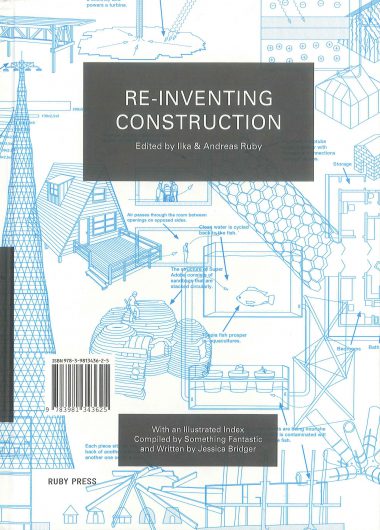Reinventing Construction — “The Cook, the Prospector, the Nomad, and Their Architect”
Author
Jeanne Gang
Editor
Ilka and Andreas Ruby
Publisher
Ruby Press
Year
2010
Design
Leonard Streich, Julian Schubert, and Elena Schütz
Tags
Jeanne Gang highlights three approaches to building with local materials.
“Issues of form in contemporary practice have a tendency to take priority over issues of construction. Today, illustration and rendering techniques—even more remote from construction—are becoming prioritized over form. This reality of our time reflects the ease with which we now employ digital media to convey ideas. However, in many projects the construction of the building itself presents an opportunity for the architect to design and create beyond the two-dimensional image. Construction materials have unique physical characteristics that are under-explored or have yet to be discovered, making it possible and exciting to work with them as generative forces for a project, rather than relying on form or imagery as a starting point. A building has the potential to be ‘about concrete,’ for example, in much the same way as a painting can be ‘about paint.’
To create a building ‘about material’ is not the same as to refine material and construction techniques in buildings. There are many architects who aspire to perfect their craft and whose work represents a lifetime of continual refinement. These architects patiently improve details with subtle changes: an endeavor that spans decades and dozens of buildings. The details are often highly expensive and require elite museums or private mansions with large project budgets to absorb their cost. This trajectory of fine tuning (which some would call fetishizing) lacks curiosity, the willingness to be surprised, the thrill of bold experimentation, and the chance to make a discovery. The accomplished master is in many ways no longer allowed to explore because his clients expect him to repeat and refine specific forms and details—years of polishing a single groove create a furrow so deep that escaping it is often impossible.
How then, to create a building with an idea that begins with construction material and technique, but which is liberated from this obsession with refinement? To do so, architects must be unafraid of radical experimentation and commit to investigations that can be deployed on relatively conventional construction sites. Within the manifold constraints of ordinary construction, the search for something new requires a focus on the materials at hand, combined with the use of tactics found outside the traditional architectural office. Looking to numerous other modes of working offers alternative ways of seeing, thinking, and making. …”
